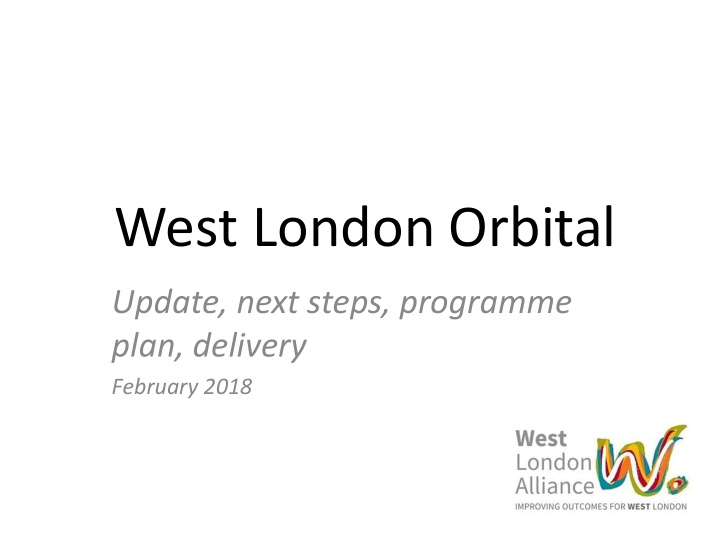



West London Orbital Update, next steps, programme plan, delivery February 2018
1. Recap and scheme overview 2. What’s been completed to date 3. Current position 4. What’s next if project proceeds (6 months – 5 years) 5. What do we (councils) need to do and when? 6. Key challenges
1. Scheme overview Technically feasible. delivered in two phases: • 4 trains per hour West Hampstead – Hounslow • 4 Trains per hour Hendon – Hounslow Modeled passenger demand by 2041 - 13,000 passengers per AM rush hour - 14,000 passengers per PM rush hour
2. What’s been done to date? • Political cross-party Mandate , Economic Prosperity has considered and approved every stage of work to date • Agreement from leaders to embed across all local plans • 5-Business Case feasibility study completed by working group including boroughs, TfL and OPDC • High Value for money scheme with a BCR = 2.2:1 (and is likely to be higher) • Potential to unlock c. 20,000 new homes and a chain of new communities across boroughs • Responded to MTS and OOC Station consultations • Successful tour of line with leaders, deputy mayor and Network Rail • Rolling stock options being explored – Battery powered trains a real option • Included in Draft MTS (proposal 83)…
Rail Tour with Leaders, Network Rail and Deputy Mayor for Transport, 29 September CONFIDENTIAL, NOT FOR CIRCULATION
3. Current position 1. MTS publication March 2018 2. Project governance (Board and Project Team) being established – WLA-led via growth directors 3. Alignment of local government anf TfL-led strands of activity
4. How might this be delivered? Four areas: 1. Rail project (TfL led, significant council involvement) 2. Reeneration and place- making (council led) 3. Funding development for preparatory planning (jointly led) 4. Engagement and consultation (jointly led) overseen by a cross-organisation programme board, delivery led by a cross-agency delivery team
6. What do councils now need to consider/do? 1. Continue to embed into Local Plans , via chief planners and our cabinets/committees 2. Work with GLA to secure MCIL contribution and/or HIF 2 funding when announced later in 2018. 3. Incorporate into Corporate Plans and MTFS 4. Commence work on land assembly along the line – to be led by consultants via funding study (match funding from TfL being sought) 5. Be ready to contribute strategic input (officer time) via WLO Board and project group 6. Prepare our planning and transport functions for WLO- related applications and activity
7. Key Risks • Identifying funding for scheme development and construction (CIL, MCIL , TfL, GLA, DfT, Planning Delivery Fund, HIF 2 etc) • Level crossings at Bollo Lane • Busy rail junction at Acton Wells • Reducing any operating subsidy that is a characteristic of orbital infrastructure that does not cut across fare zones. All have possible solutions – no show-stoppers identified to date
Contact Luke Ward Head of Growth, Employment and Skills wardlu@ealing.ov.uk
Recommend
More recommend